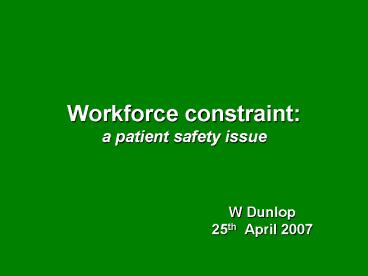Workforce constraint: a patient safety issue PowerPoint PPT Presentation
1 / 36
Title: Workforce constraint: a patient safety issue
1
Workforce constrainta patient safety issue
- W Dunlop
- 25th April 2007
2
Content
- Is there a problem?
- Will more staff help?
- What is happening now?
- What is needed for the future?
3
Is there a problem?
- CEMACH data
- Suboptimal care for mothers and babies
- Northwick Park
- Insufficient supervision by experienced
clinicians - NHS Litigation Authority
- Increasing payments for obstetrics
4
NHSLA payments for obstetric-related
incidents 1996 - 2002
300
million
200
100
0
RCOG Safer Childbirth Minimum Standards for
Service Provision and Care in Labour
5
Content
- Is there a problem?
- Will more staff help?
- What is happening now?
- What is needed for the future?
6
Will more staff help?
- Senior involvement
- Intervention rates
- Trainee involvement
- WTD compliance
- Midwife involvement
- Funded establishment
7
Compliance with WTD 2009 hours target by pay band
and specialty
100
doctors in training
80
60
40
20
0
AE
OG
Surgery
Psychiatry
Dentistry
Average
Medicine
Pathology
Radiology
Paediatrics
Public Health
Anaesthetics
8
In your view, is the funded midwifery
establishment adequate for the level of activity
undertaken in your trust?
Year
0
20
40
60
80
100
Percent
Annual survey of UK Heads of Midwifery Service
9
Content
- Is there a problem?
- Will more staff help?
- What is happening now?
- What is needed for the future?
10
Net NHS Expenditure, 2002-03 to 2006-08 Net NHS Expenditure, 2002-03 to 2006-08
England
100
billion
80
60
40
20
0
Department of Health
70 of NHS funding is spent on staffing costs
11
Total NHS staff 1995 - 2005
1500000
1000000
500000
0
1995
1996
1997
1998
1999
2000
2001
2002
2003
2004
2005
House of Commons Health Committee, 2007
12
Nurses and doctors 1995 - 2005
1995
1996
1997
1998
1999
2000
2001
2002
2003
2004
2005
House of Commons Health Committee, 2007
13
Consultants, registrars and other training
grades 1995 - 2005
1995
1996
1997
1998
1999
2000
2001
2002
2003
2004
2005
House of Commons Health Committee, 2007
14
Annual percentage increments in career grade
doctors in UK, 1998 - 2004
20
15
10
5
0
1998
1999
2000
2001
2002
2003
2004
Northern Ireland numbers included in 2001,2002
and 2003 only
15
NHS workforce growth 1999 - 2005
0
10
20
30
40
50
60
70
percent
House of Commons Health Committee, 2007
16
Comparison of NHS Plan (2000) growth targets with
actual workforce growth (1999 2004)
350
250
150
50
0
-50
House of Commons Health Committee, 2007
17
Potential unemployment?
Physiotherapy graduates in 2006 68 unable to
find NHS work (usual unemployment rate 5)
Nursing graduates in 2006 40 unable to find NHS
work within 6 months (usual rate 15)
Medical trainees in 2007?
House of Commons Health Committee, 2007
18
Workforce considerations conversion to MMC
training posts
Total number of SHO and Trust grade posts 21,000
Surplus
F2 posts
GP trainees
Specialist trainees
www.mmc.nhs.uk
19
ST posts 2007
Total number of SHO and Trust grade posts 21,000
Predicted surplus 3,700
Alleged number of applicants for ST posts 33,000
Possible deficit 8,300
20
There has been a disastrous failure of workforce
planning.
21
Content
- Is there a problem?
- Will more staff help?
- What is happening now?
- What is needed for the future?
22
Training costs of health service professionals
300000
200000
100000
0
(Netten et al, 1998)
23
Average consultant earnings, 2002 - 2006
120000
GBP
80000
40000
0
Year
House of Commons Health Committee, 2007
24
Overspending on pay reform relative to projected
spending 2004 - 2005
300
million
250
200
150
100
50
0
House of Commons Health Committee, 2007
25
Some Questions
- What can be done by others?
- What must be done by doctors?
- What is the added value of a doctor?
- What do patients want?
- How will health care be delivered?
- How do we train for new roles?
26
Factors to be addressed
27
Other Factors for Change
- National Service Framework
- Election Manifesto
- Postgraduate training
- RCOG / RCM / NICE initiatives
28
National Service Framework for Children Young
People and Maternity Services
29
Maternity Services
- Standards for service provision
- Framework for clinical guidelines
- Adaptable to local circumstances
- Acceptable for women
- Workable for health carers
30
Manifesto Commitment
- By 2009
- Choice of place and pain relief
- Named midwife
- Links to Childrens Centres
31
- Choice of
- Access to care
- Type of care
- Place of birth
- Postnatal care
32
The RCM Position
With an estimated 10 000 more midwives needed to
deliver first-class maternity services, there is
still a long way to go.
RCM News and Appointments 2006
33
2004
34
Aims of project
- Information from compliant units
- Impact upon training and CPD
- Evaluation of models
- Communication strategy
35
NICE guidelines for clinical care
- Antenatal care
- Caesarean Section
- Intrapartum care
- Postnatal care
- Complex pregnancies
36
Conclusion
- Workforce expansion unplanned
- Major changes anticipated
- Need to define roles
- Standards clearly defined
- Potential for more trained doctors

